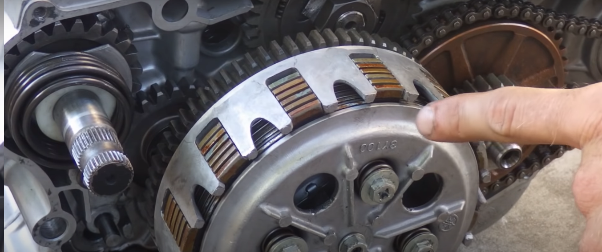The clutch is a word that is joined to automobiles. But it can also be seen on bicycles while some parts are found on the rear derailleur, mainly on mountain bikes.
It also serves as a medium to stop the arm from vigorously around, which could damage the frame or even cause the chain to finally unship by tendering the metal at the highest top of the derailleur.
It also serves the purpose of restricting the derailleur movement to maintain the chain’s state.
So many people, when traveling over a terrain that is not level, unknown to them that the weight of the chain can cause a typical derailleur to move gently just because of the movement.
It might, along the line, make the chain raise a noisy sound that can piss up or so frustrating, or it might switch off the chainrings.
In this article, I would like you to join me in learning more about the clutch on a bicycle and what it does on a bike, together with other topics that l will be sharing with you.
Continue reading, as you will find this article more interesting!
Let’s get started!
Is There A Clutch On A Bicycle?
Yes, of course. As I said in the information above, many individuals are indeed associated with automobiles, but clutch can be found in bicycles but mainly on mountain bikes.
What Does Clutch Do On A Bike?
It is responsible for connecting and disconnecting the source of the engine’s power from being transmitted. However, the bike rider might adjust the gears while riding the bike.
But it makes the rider stop while the engine is running. In this scenario, the rider might use his left hand, which is attached to the lever of the handlebars, to keep the clutch engaging.
A motorcycle’s clutch is in charge of connecting and disengaging the engine’s power from the transmission. The biker can seamlessly change gears while riding, thanks to this.
Additionally, it enables the motorcycle to be stopped while the engine is still running. The rider’s left hand typically uses a lever on the handlebars to hold the clutch.
Why Don’t Bicycles Have A Clutch?
I will say to you that majority of the bicycles have a clutch, but it is an overrunning one at that, which simply signifies that if the bike rider stops pedaling, it might cause the bike a motion to pedal; it is a problematic cause that process if the rider’s cloth got caught on such a sprocket, the bike rider might simply have to stop riding.
What Is The purpose of The Clutch On A Mountain Bike?
When bike riders go riding on a terrain that is not level, the clutch is designed to stronger tighten the chain to prevent chain slap.
The chain slap typically occurs when the chain lashes on the chain stay. It might cause terrible damage, which is why the clutch is provided to stop such from taking place.

Should We Press Clutch While Turning In Bike?
Of course, I will advise you to use the clutch while turning the bike because it simply eases off the transition of the bike by preserving control of the bike.
But some bike riders do have other experiences or methods by which they employ to control the bike’s speed while turning and closing the throttle. Riding safely is very important, and following the manufacturer’s guidelines for a specific bike is necessary.
Is It Okay To Ride The Clutch?
No, it is not! Why? Because when the rider rides on the clutch, problems might arise as the rider constantly engages in the clutch while riding. In such a scenario, it can cause a jerking, bucking, or even halt. So, therefore, depending on the clutch repeatedly will lead to damage and instability.
When Should I Use Clutch?
As I said earlier in the information above, the clutch is part of a bicycle that stops an engine’s power from a transmitting level.
So therefore, when you are to use the clutch when you are to stop the engine from obstructing the gear, especially when you are on a ride, thereby using the clutch to shift gears or even when you need to put your bike to a stop.
Does Riding The Clutch Damage Your Bike?
No! It won’t damage your bike, but that can only be achieved if you disengage the clutch by shifting into normal. Therefore your engine won’t get worse, and it saves fuel.
Also, it is such a good practice, unless it is in a case whereby you are pedaling for a long time and then detach the driving train, it will save a good amount of gasoline.
Note. Be careful while you release the clutch at the end while on a drive, especially when going down the hill In high gear.
Is It Bad To Hold The Clutch At A Stop Light?
No, not really! But I will advise that you should leave your bike in gear at lights, especially when the stop signs and stop lights come up; it signifies that you should hold your clutch and keep your bike in gear just in case you need to move quickly to avoid any vehicle coming behind you.
Does Clutch Reduce Speed?
This will only happen if the clutch is worn out; it will stop the power engine from giving power as a source to the transmission. In this case, it will cause bad acceleration and speed increase by the machine, which will result in lousy mileage.
Is It Okay To Ride The Clutch In First?
To achieve this, you must remove your foot from the clutch pedal whenever you are in riding gear, even first gear. And then, you to smoothly change your bike from one state to another, especially in first gear. Do well to disengage the clutch. It is essential.
How Long Is Too Long To Hold Clutch?
It all depends on the bike you ride on. Still, if you want the life of the bike to last long, thereby not causing excessive wear and tear, I will advise you should use the clutch when it is needed, e.g., shifting of gears, a precise one at that, and then gently release the clutch lever, so, therefore, don’t use the clutch for an extended period.
What Burns Out A Clutch?
It is caused as a result of constant heat that is produced by a clutch or by an overuse clutch. Therefore, it creates too much heat and a sour odor. Over time the friction materials of a clutch are degraded.
How Long Should You Hold The Clutch?
It All depends on the bike’s situation. Still, I will advise that you use the clutch whenever you want to start the cycle, releasing it gradually as you begin to move and when to shift the gears and stop, thereby making sure it stops on normal, and lastly, when you want to maneuver.
Conclusion.
You have to gain more knowledge about how clutch does on a bike; I know with this knowledge, you will be able to manage your bicycle very well and avoid or do away with anything that will cause damage to the parts of your shifting gear. Only apply your gear with a clutch.
